INTEGRATED EMERGENCY PLAN
VerifiedAdded on 2024/05/14
|11
|3574
|168
AI Summary
Contribute Materials
Your contribution can guide someone’s learning journey. Share your
documents today.

INTEGRATED EMERGENCY PLAN
Name of the student
Name of the university
Author’s note
1
Name of the student
Name of the university
Author’s note
1
Secure Best Marks with AI Grader
Need help grading? Try our AI Grader for instant feedback on your assignments.
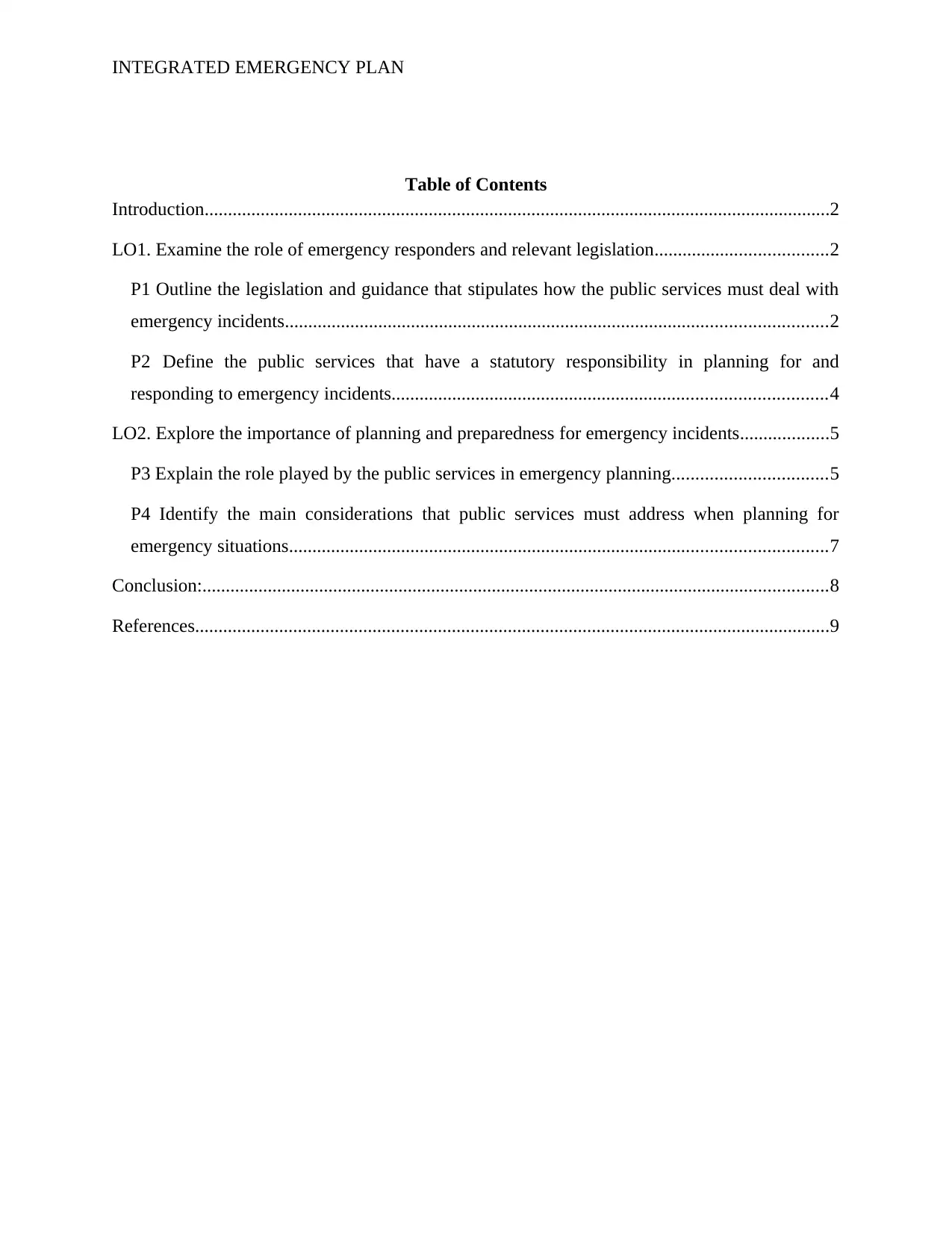
INTEGRATED EMERGENCY PLAN
Table of Contents
Introduction......................................................................................................................................2
LO1. Examine the role of emergency responders and relevant legislation.....................................2
P1 Outline the legislation and guidance that stipulates how the public services must deal with
emergency incidents....................................................................................................................2
P2 Define the public services that have a statutory responsibility in planning for and
responding to emergency incidents.............................................................................................4
LO2. Explore the importance of planning and preparedness for emergency incidents...................5
P3 Explain the role played by the public services in emergency planning.................................5
P4 Identify the main considerations that public services must address when planning for
emergency situations...................................................................................................................7
Conclusion:......................................................................................................................................8
References........................................................................................................................................9
Table of Contents
Introduction......................................................................................................................................2
LO1. Examine the role of emergency responders and relevant legislation.....................................2
P1 Outline the legislation and guidance that stipulates how the public services must deal with
emergency incidents....................................................................................................................2
P2 Define the public services that have a statutory responsibility in planning for and
responding to emergency incidents.............................................................................................4
LO2. Explore the importance of planning and preparedness for emergency incidents...................5
P3 Explain the role played by the public services in emergency planning.................................5
P4 Identify the main considerations that public services must address when planning for
emergency situations...................................................................................................................7
Conclusion:......................................................................................................................................8
References........................................................................................................................................9
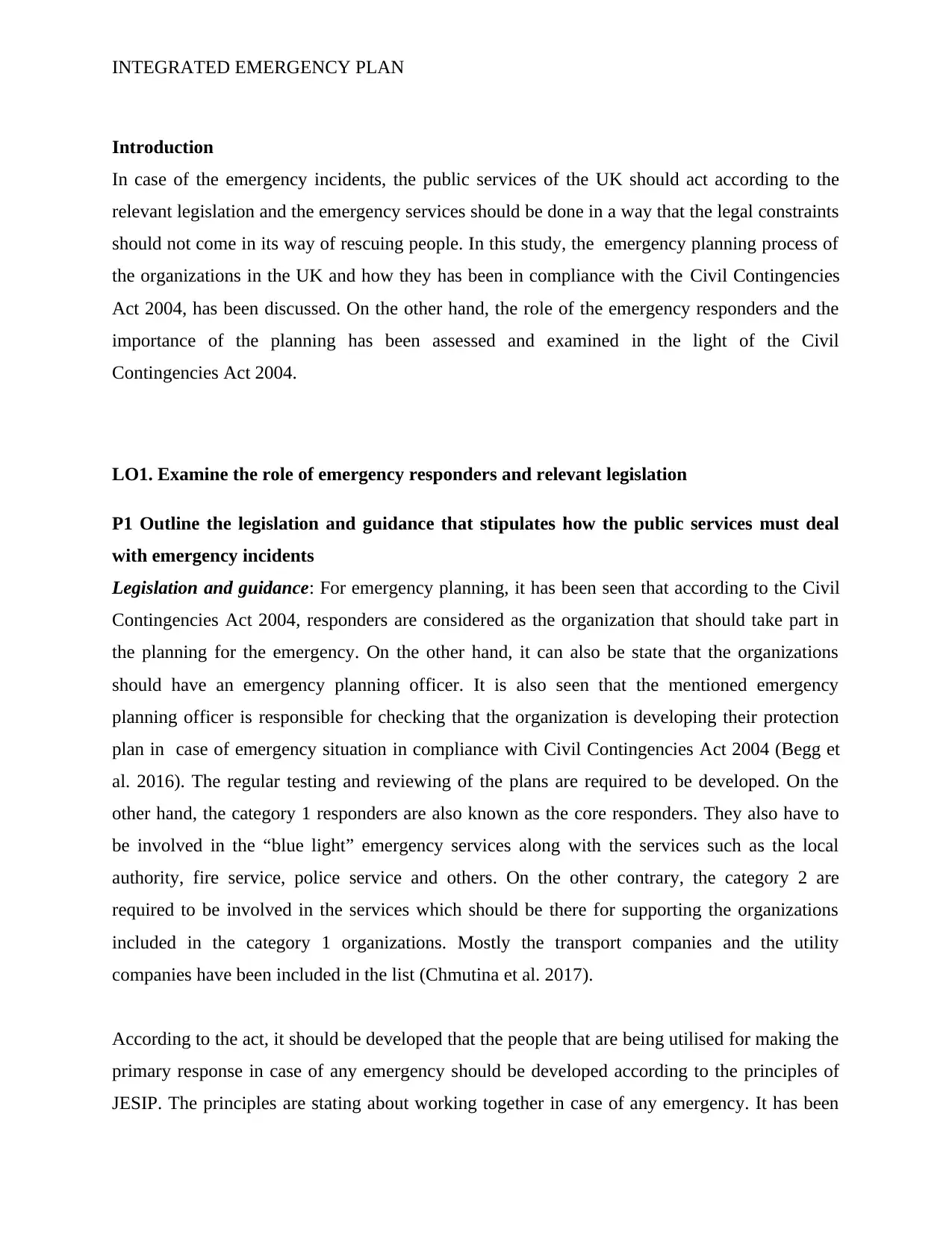
INTEGRATED EMERGENCY PLAN
Introduction
In case of the emergency incidents, the public services of the UK should act according to the
relevant legislation and the emergency services should be done in a way that the legal constraints
should not come in its way of rescuing people. In this study, the emergency planning process of
the organizations in the UK and how they has been in compliance with the Civil Contingencies
Act 2004, has been discussed. On the other hand, the role of the emergency responders and the
importance of the planning has been assessed and examined in the light of the Civil
Contingencies Act 2004.
LO1. Examine the role of emergency responders and relevant legislation
P1 Outline the legislation and guidance that stipulates how the public services must deal
with emergency incidents
Legislation and guidance: For emergency planning, it has been seen that according to the Civil
Contingencies Act 2004, responders are considered as the organization that should take part in
the planning for the emergency. On the other hand, it can also be state that the organizations
should have an emergency planning officer. It is also seen that the mentioned emergency
planning officer is responsible for checking that the organization is developing their protection
plan in case of emergency situation in compliance with Civil Contingencies Act 2004 (Begg et
al. 2016). The regular testing and reviewing of the plans are required to be developed. On the
other hand, the category 1 responders are also known as the core responders. They also have to
be involved in the “blue light” emergency services along with the services such as the local
authority, fire service, police service and others. On the other contrary, the category 2 are
required to be involved in the services which should be there for supporting the organizations
included in the category 1 organizations. Mostly the transport companies and the utility
companies have been included in the list (Chmutina et al. 2017).
According to the act, it should be developed that the people that are being utilised for making the
primary response in case of any emergency should be developed according to the principles of
JESIP. The principles are stating about working together in case of any emergency. It has been
Introduction
In case of the emergency incidents, the public services of the UK should act according to the
relevant legislation and the emergency services should be done in a way that the legal constraints
should not come in its way of rescuing people. In this study, the emergency planning process of
the organizations in the UK and how they has been in compliance with the Civil Contingencies
Act 2004, has been discussed. On the other hand, the role of the emergency responders and the
importance of the planning has been assessed and examined in the light of the Civil
Contingencies Act 2004.
LO1. Examine the role of emergency responders and relevant legislation
P1 Outline the legislation and guidance that stipulates how the public services must deal
with emergency incidents
Legislation and guidance: For emergency planning, it has been seen that according to the Civil
Contingencies Act 2004, responders are considered as the organization that should take part in
the planning for the emergency. On the other hand, it can also be state that the organizations
should have an emergency planning officer. It is also seen that the mentioned emergency
planning officer is responsible for checking that the organization is developing their protection
plan in case of emergency situation in compliance with Civil Contingencies Act 2004 (Begg et
al. 2016). The regular testing and reviewing of the plans are required to be developed. On the
other hand, the category 1 responders are also known as the core responders. They also have to
be involved in the “blue light” emergency services along with the services such as the local
authority, fire service, police service and others. On the other contrary, the category 2 are
required to be involved in the services which should be there for supporting the organizations
included in the category 1 organizations. Mostly the transport companies and the utility
companies have been included in the list (Chmutina et al. 2017).
According to the act, it should be developed that the people that are being utilised for making the
primary response in case of any emergency should be developed according to the principles of
JESIP. The principles are stating about working together in case of any emergency. It has been
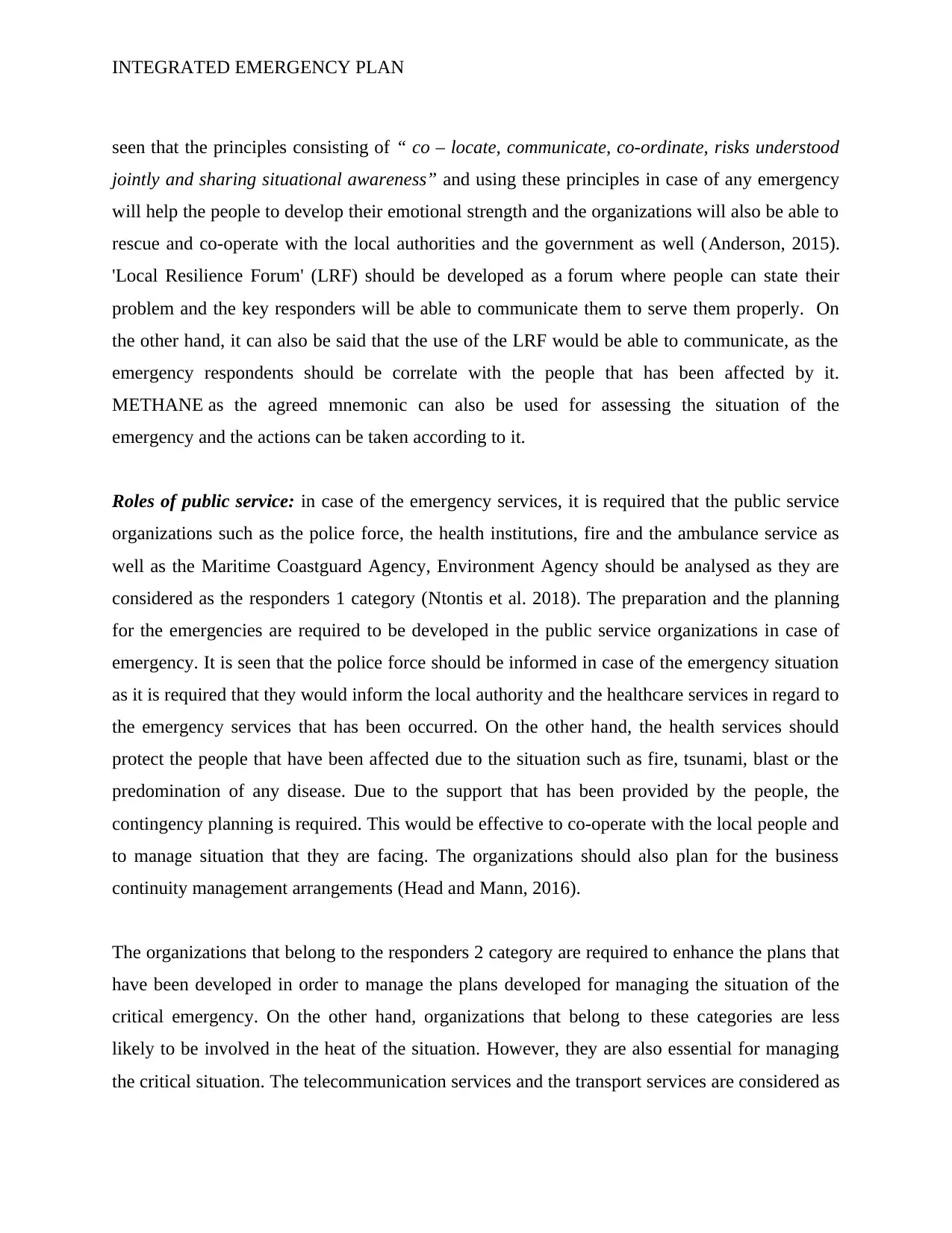
INTEGRATED EMERGENCY PLAN
seen that the principles consisting of “ co – locate, communicate, co-ordinate, risks understood
jointly and sharing situational awareness” and using these principles in case of any emergency
will help the people to develop their emotional strength and the organizations will also be able to
rescue and co-operate with the local authorities and the government as well (Anderson, 2015).
'Local Resilience Forum' (LRF) should be developed as a forum where people can state their
problem and the key responders will be able to communicate them to serve them properly. On
the other hand, it can also be said that the use of the LRF would be able to communicate, as the
emergency respondents should be correlate with the people that has been affected by it.
METHANE as the agreed mnemonic can also be used for assessing the situation of the
emergency and the actions can be taken according to it.
Roles of public service: in case of the emergency services, it is required that the public service
organizations such as the police force, the health institutions, fire and the ambulance service as
well as the Maritime Coastguard Agency, Environment Agency should be analysed as they are
considered as the responders 1 category (Ntontis et al. 2018). The preparation and the planning
for the emergencies are required to be developed in the public service organizations in case of
emergency. It is seen that the police force should be informed in case of the emergency situation
as it is required that they would inform the local authority and the healthcare services in regard to
the emergency services that has been occurred. On the other hand, the health services should
protect the people that have been affected due to the situation such as fire, tsunami, blast or the
predomination of any disease. Due to the support that has been provided by the people, the
contingency planning is required. This would be effective to co-operate with the local people and
to manage situation that they are facing. The organizations should also plan for the business
continuity management arrangements (Head and Mann, 2016).
The organizations that belong to the responders 2 category are required to enhance the plans that
have been developed in order to manage the plans developed for managing the situation of the
critical emergency. On the other hand, organizations that belong to these categories are less
likely to be involved in the heat of the situation. However, they are also essential for managing
the critical situation. The telecommunication services and the transport services are considered as
seen that the principles consisting of “ co – locate, communicate, co-ordinate, risks understood
jointly and sharing situational awareness” and using these principles in case of any emergency
will help the people to develop their emotional strength and the organizations will also be able to
rescue and co-operate with the local authorities and the government as well (Anderson, 2015).
'Local Resilience Forum' (LRF) should be developed as a forum where people can state their
problem and the key responders will be able to communicate them to serve them properly. On
the other hand, it can also be said that the use of the LRF would be able to communicate, as the
emergency respondents should be correlate with the people that has been affected by it.
METHANE as the agreed mnemonic can also be used for assessing the situation of the
emergency and the actions can be taken according to it.
Roles of public service: in case of the emergency services, it is required that the public service
organizations such as the police force, the health institutions, fire and the ambulance service as
well as the Maritime Coastguard Agency, Environment Agency should be analysed as they are
considered as the responders 1 category (Ntontis et al. 2018). The preparation and the planning
for the emergencies are required to be developed in the public service organizations in case of
emergency. It is seen that the police force should be informed in case of the emergency situation
as it is required that they would inform the local authority and the healthcare services in regard to
the emergency services that has been occurred. On the other hand, the health services should
protect the people that have been affected due to the situation such as fire, tsunami, blast or the
predomination of any disease. Due to the support that has been provided by the people, the
contingency planning is required. This would be effective to co-operate with the local people and
to manage situation that they are facing. The organizations should also plan for the business
continuity management arrangements (Head and Mann, 2016).
The organizations that belong to the responders 2 category are required to enhance the plans that
have been developed in order to manage the plans developed for managing the situation of the
critical emergency. On the other hand, organizations that belong to these categories are less
likely to be involved in the heat of the situation. However, they are also essential for managing
the critical situation. The telecommunication services and the transport services are considered as
Secure Best Marks with AI Grader
Need help grading? Try our AI Grader for instant feedback on your assignments.
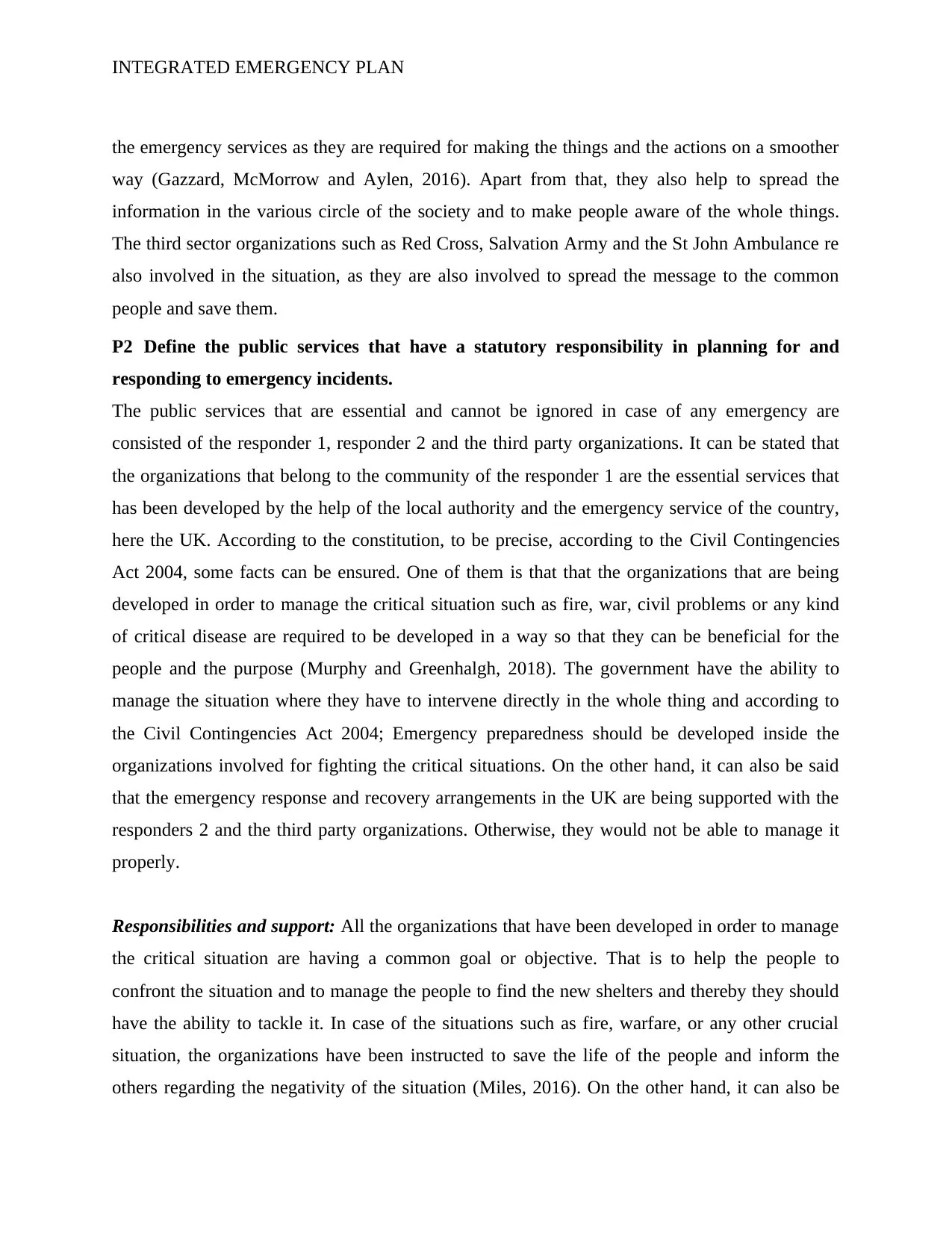
INTEGRATED EMERGENCY PLAN
the emergency services as they are required for making the things and the actions on a smoother
way (Gazzard, McMorrow and Aylen, 2016). Apart from that, they also help to spread the
information in the various circle of the society and to make people aware of the whole things.
The third sector organizations such as Red Cross, Salvation Army and the St John Ambulance re
also involved in the situation, as they are also involved to spread the message to the common
people and save them.
P2 Define the public services that have a statutory responsibility in planning for and
responding to emergency incidents.
The public services that are essential and cannot be ignored in case of any emergency are
consisted of the responder 1, responder 2 and the third party organizations. It can be stated that
the organizations that belong to the community of the responder 1 are the essential services that
has been developed by the help of the local authority and the emergency service of the country,
here the UK. According to the constitution, to be precise, according to the Civil Contingencies
Act 2004, some facts can be ensured. One of them is that that the organizations that are being
developed in order to manage the critical situation such as fire, war, civil problems or any kind
of critical disease are required to be developed in a way so that they can be beneficial for the
people and the purpose (Murphy and Greenhalgh, 2018). The government have the ability to
manage the situation where they have to intervene directly in the whole thing and according to
the Civil Contingencies Act 2004; Emergency preparedness should be developed inside the
organizations involved for fighting the critical situations. On the other hand, it can also be said
that the emergency response and recovery arrangements in the UK are being supported with the
responders 2 and the third party organizations. Otherwise, they would not be able to manage it
properly.
Responsibilities and support: All the organizations that have been developed in order to manage
the critical situation are having a common goal or objective. That is to help the people to
confront the situation and to manage the people to find the new shelters and thereby they should
have the ability to tackle it. In case of the situations such as fire, warfare, or any other crucial
situation, the organizations have been instructed to save the life of the people and inform the
others regarding the negativity of the situation (Miles, 2016). On the other hand, it can also be
the emergency services as they are required for making the things and the actions on a smoother
way (Gazzard, McMorrow and Aylen, 2016). Apart from that, they also help to spread the
information in the various circle of the society and to make people aware of the whole things.
The third sector organizations such as Red Cross, Salvation Army and the St John Ambulance re
also involved in the situation, as they are also involved to spread the message to the common
people and save them.
P2 Define the public services that have a statutory responsibility in planning for and
responding to emergency incidents.
The public services that are essential and cannot be ignored in case of any emergency are
consisted of the responder 1, responder 2 and the third party organizations. It can be stated that
the organizations that belong to the community of the responder 1 are the essential services that
has been developed by the help of the local authority and the emergency service of the country,
here the UK. According to the constitution, to be precise, according to the Civil Contingencies
Act 2004, some facts can be ensured. One of them is that that the organizations that are being
developed in order to manage the critical situation such as fire, war, civil problems or any kind
of critical disease are required to be developed in a way so that they can be beneficial for the
people and the purpose (Murphy and Greenhalgh, 2018). The government have the ability to
manage the situation where they have to intervene directly in the whole thing and according to
the Civil Contingencies Act 2004; Emergency preparedness should be developed inside the
organizations involved for fighting the critical situations. On the other hand, it can also be said
that the emergency response and recovery arrangements in the UK are being supported with the
responders 2 and the third party organizations. Otherwise, they would not be able to manage it
properly.
Responsibilities and support: All the organizations that have been developed in order to manage
the critical situation are having a common goal or objective. That is to help the people to
confront the situation and to manage the people to find the new shelters and thereby they should
have the ability to tackle it. In case of the situations such as fire, warfare, or any other crucial
situation, the organizations have been instructed to save the life of the people and inform the
others regarding the negativity of the situation (Miles, 2016). On the other hand, it can also be
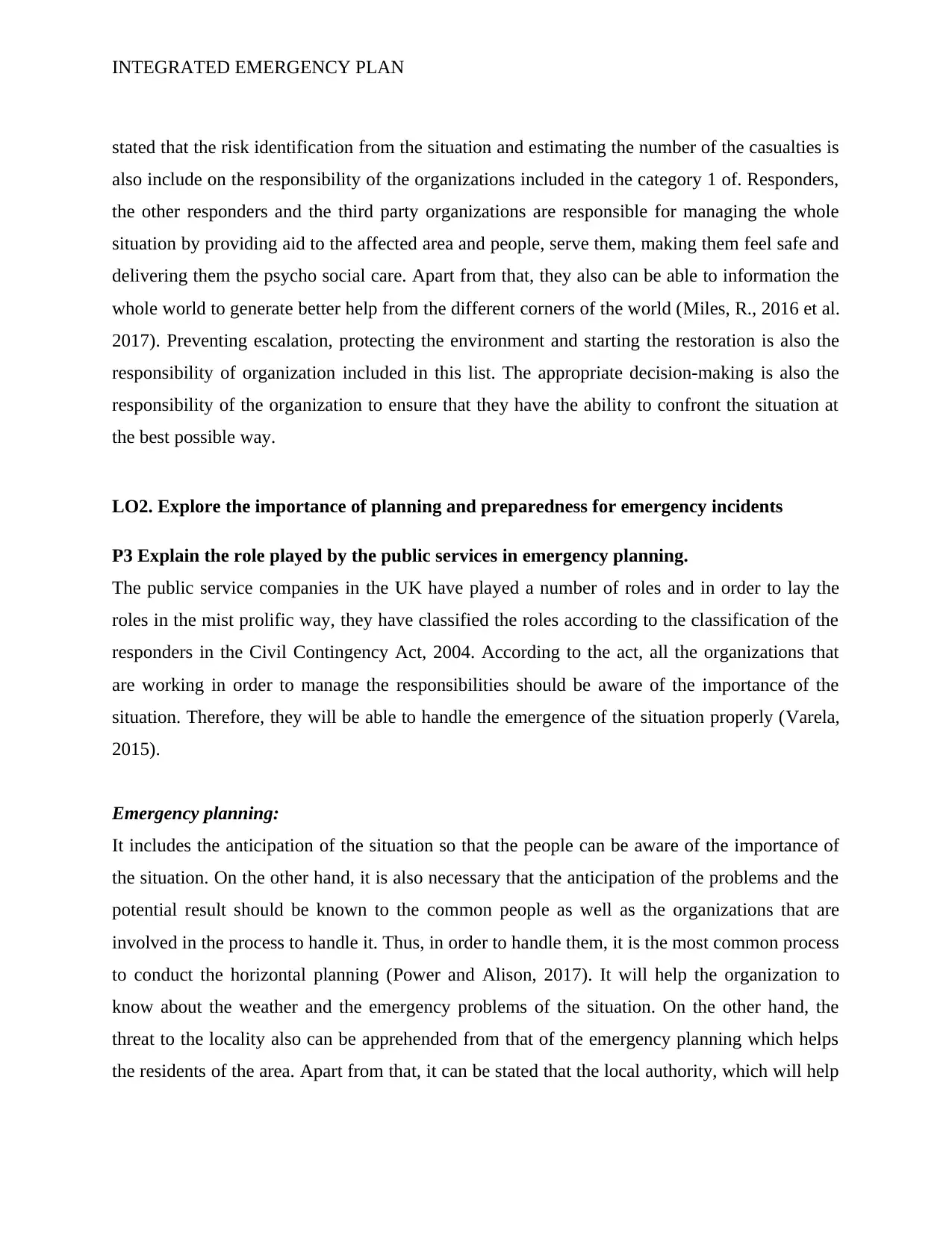
INTEGRATED EMERGENCY PLAN
stated that the risk identification from the situation and estimating the number of the casualties is
also include on the responsibility of the organizations included in the category 1 of. Responders,
the other responders and the third party organizations are responsible for managing the whole
situation by providing aid to the affected area and people, serve them, making them feel safe and
delivering them the psycho social care. Apart from that, they also can be able to information the
whole world to generate better help from the different corners of the world (Miles, R., 2016 et al.
2017). Preventing escalation, protecting the environment and starting the restoration is also the
responsibility of organization included in this list. The appropriate decision-making is also the
responsibility of the organization to ensure that they have the ability to confront the situation at
the best possible way.
LO2. Explore the importance of planning and preparedness for emergency incidents
P3 Explain the role played by the public services in emergency planning.
The public service companies in the UK have played a number of roles and in order to lay the
roles in the mist prolific way, they have classified the roles according to the classification of the
responders in the Civil Contingency Act, 2004. According to the act, all the organizations that
are working in order to manage the responsibilities should be aware of the importance of the
situation. Therefore, they will be able to handle the emergence of the situation properly (Varela,
2015).
Emergency planning:
It includes the anticipation of the situation so that the people can be aware of the importance of
the situation. On the other hand, it is also necessary that the anticipation of the problems and the
potential result should be known to the common people as well as the organizations that are
involved in the process to handle it. Thus, in order to handle them, it is the most common process
to conduct the horizontal planning (Power and Alison, 2017). It will help the organization to
know about the weather and the emergency problems of the situation. On the other hand, the
threat to the locality also can be apprehended from that of the emergency planning which helps
the residents of the area. Apart from that, it can be stated that the local authority, which will help
stated that the risk identification from the situation and estimating the number of the casualties is
also include on the responsibility of the organizations included in the category 1 of. Responders,
the other responders and the third party organizations are responsible for managing the whole
situation by providing aid to the affected area and people, serve them, making them feel safe and
delivering them the psycho social care. Apart from that, they also can be able to information the
whole world to generate better help from the different corners of the world (Miles, R., 2016 et al.
2017). Preventing escalation, protecting the environment and starting the restoration is also the
responsibility of organization included in this list. The appropriate decision-making is also the
responsibility of the organization to ensure that they have the ability to confront the situation at
the best possible way.
LO2. Explore the importance of planning and preparedness for emergency incidents
P3 Explain the role played by the public services in emergency planning.
The public service companies in the UK have played a number of roles and in order to lay the
roles in the mist prolific way, they have classified the roles according to the classification of the
responders in the Civil Contingency Act, 2004. According to the act, all the organizations that
are working in order to manage the responsibilities should be aware of the importance of the
situation. Therefore, they will be able to handle the emergence of the situation properly (Varela,
2015).
Emergency planning:
It includes the anticipation of the situation so that the people can be aware of the importance of
the situation. On the other hand, it is also necessary that the anticipation of the problems and the
potential result should be known to the common people as well as the organizations that are
involved in the process to handle it. Thus, in order to handle them, it is the most common process
to conduct the horizontal planning (Power and Alison, 2017). It will help the organization to
know about the weather and the emergency problems of the situation. On the other hand, the
threat to the locality also can be apprehended from that of the emergency planning which helps
the residents of the area. Apart from that, it can be stated that the local authority, which will help
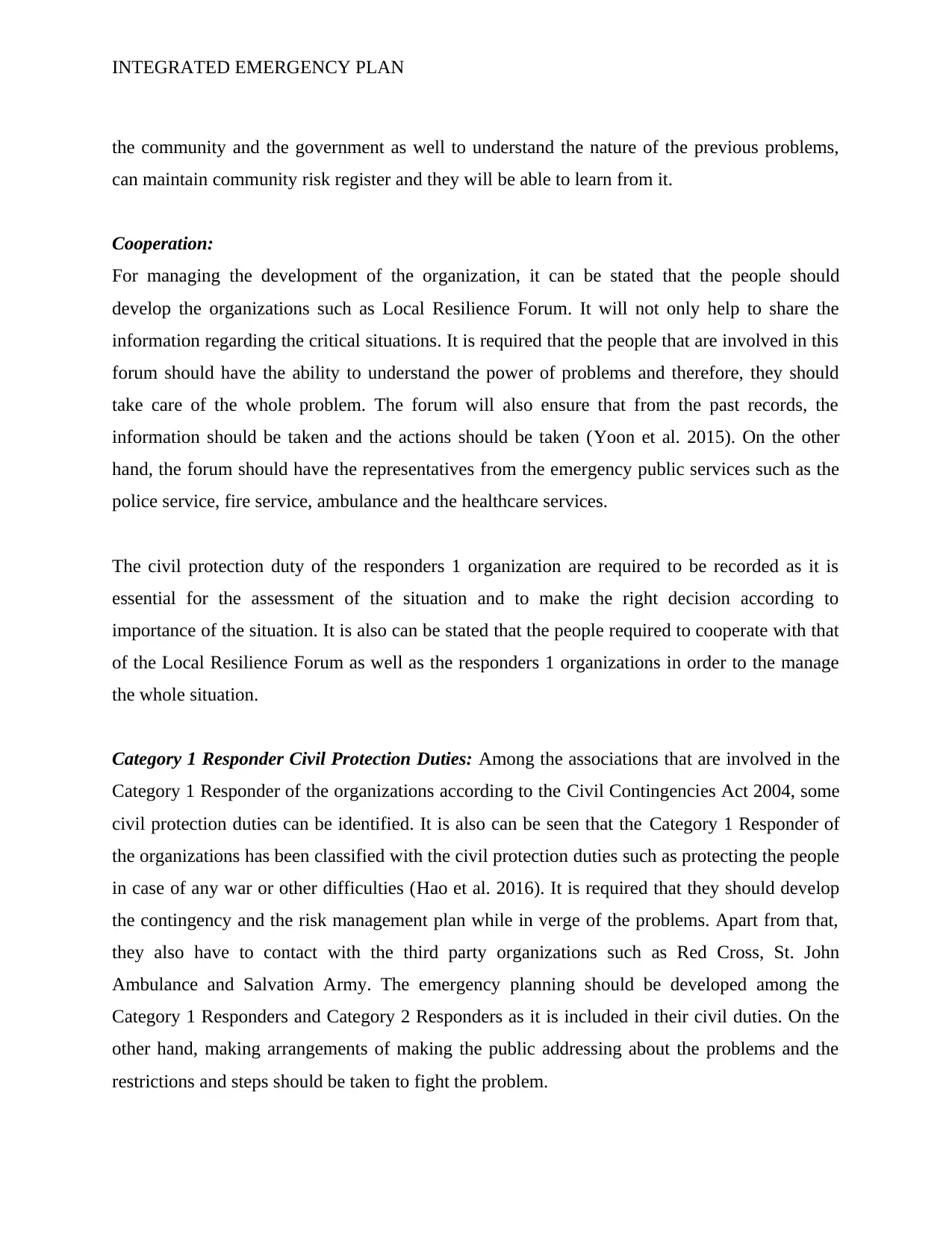
INTEGRATED EMERGENCY PLAN
the community and the government as well to understand the nature of the previous problems,
can maintain community risk register and they will be able to learn from it.
Cooperation:
For managing the development of the organization, it can be stated that the people should
develop the organizations such as Local Resilience Forum. It will not only help to share the
information regarding the critical situations. It is required that the people that are involved in this
forum should have the ability to understand the power of problems and therefore, they should
take care of the whole problem. The forum will also ensure that from the past records, the
information should be taken and the actions should be taken (Yoon et al. 2015). On the other
hand, the forum should have the representatives from the emergency public services such as the
police service, fire service, ambulance and the healthcare services.
The civil protection duty of the responders 1 organization are required to be recorded as it is
essential for the assessment of the situation and to make the right decision according to
importance of the situation. It is also can be stated that the people required to cooperate with that
of the Local Resilience Forum as well as the responders 1 organizations in order to the manage
the whole situation.
Category 1 Responder Civil Protection Duties: Among the associations that are involved in the
Category 1 Responder of the organizations according to the Civil Contingencies Act 2004, some
civil protection duties can be identified. It is also can be seen that the Category 1 Responder of
the organizations has been classified with the civil protection duties such as protecting the people
in case of any war or other difficulties (Hao et al. 2016). It is required that they should develop
the contingency and the risk management plan while in verge of the problems. Apart from that,
they also have to contact with the third party organizations such as Red Cross, St. John
Ambulance and Salvation Army. The emergency planning should be developed among the
Category 1 Responders and Category 2 Responders as it is included in their civil duties. On the
other hand, making arrangements of making the public addressing about the problems and the
restrictions and steps should be taken to fight the problem.
the community and the government as well to understand the nature of the previous problems,
can maintain community risk register and they will be able to learn from it.
Cooperation:
For managing the development of the organization, it can be stated that the people should
develop the organizations such as Local Resilience Forum. It will not only help to share the
information regarding the critical situations. It is required that the people that are involved in this
forum should have the ability to understand the power of problems and therefore, they should
take care of the whole problem. The forum will also ensure that from the past records, the
information should be taken and the actions should be taken (Yoon et al. 2015). On the other
hand, the forum should have the representatives from the emergency public services such as the
police service, fire service, ambulance and the healthcare services.
The civil protection duty of the responders 1 organization are required to be recorded as it is
essential for the assessment of the situation and to make the right decision according to
importance of the situation. It is also can be stated that the people required to cooperate with that
of the Local Resilience Forum as well as the responders 1 organizations in order to the manage
the whole situation.
Category 1 Responder Civil Protection Duties: Among the associations that are involved in the
Category 1 Responder of the organizations according to the Civil Contingencies Act 2004, some
civil protection duties can be identified. It is also can be seen that the Category 1 Responder of
the organizations has been classified with the civil protection duties such as protecting the people
in case of any war or other difficulties (Hao et al. 2016). It is required that they should develop
the contingency and the risk management plan while in verge of the problems. Apart from that,
they also have to contact with the third party organizations such as Red Cross, St. John
Ambulance and Salvation Army. The emergency planning should be developed among the
Category 1 Responders and Category 2 Responders as it is included in their civil duties. On the
other hand, making arrangements of making the public addressing about the problems and the
restrictions and steps should be taken to fight the problem.
Paraphrase This Document
Need a fresh take? Get an instant paraphrase of this document with our AI Paraphraser
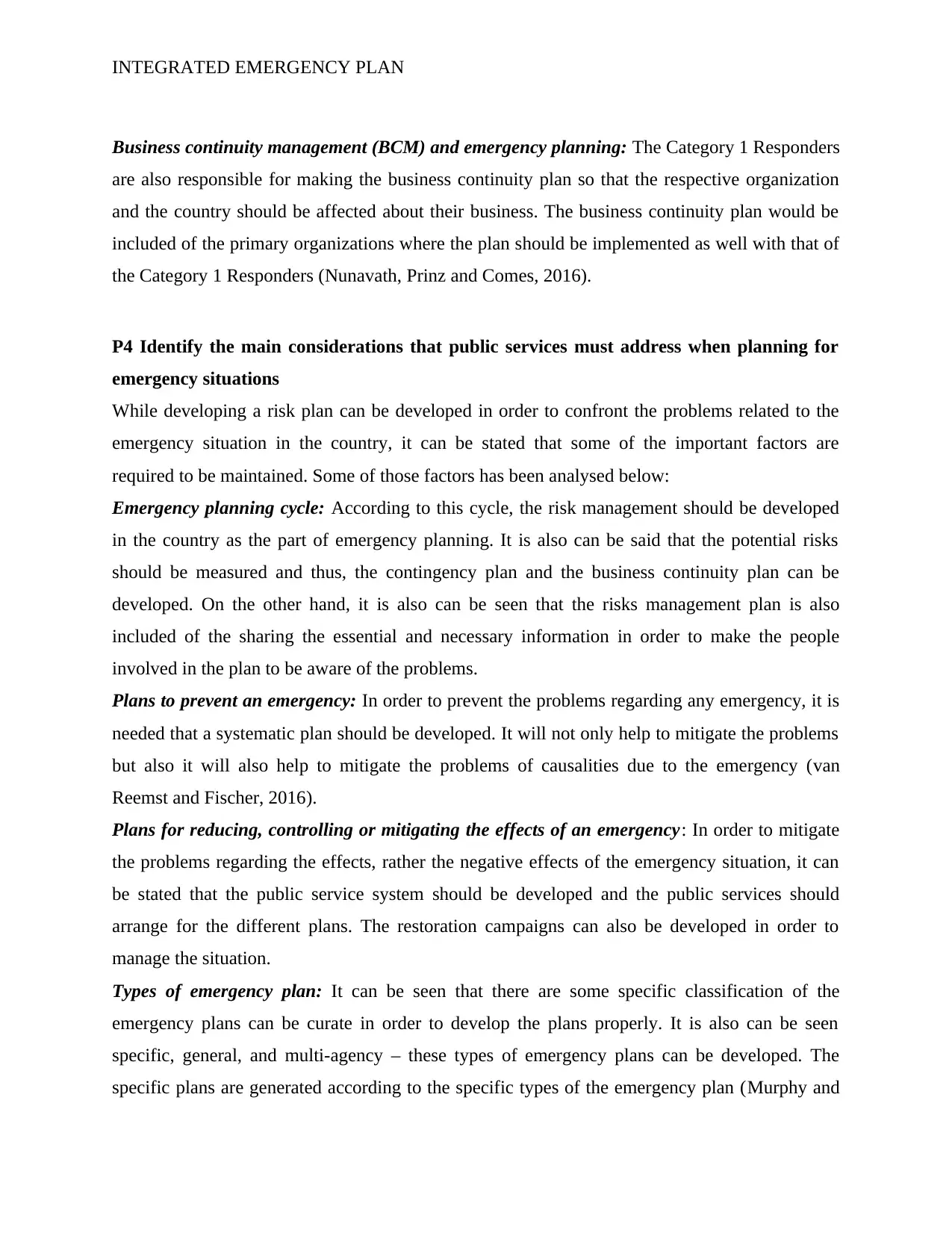
INTEGRATED EMERGENCY PLAN
Business continuity management (BCM) and emergency planning: The Category 1 Responders
are also responsible for making the business continuity plan so that the respective organization
and the country should be affected about their business. The business continuity plan would be
included of the primary organizations where the plan should be implemented as well with that of
the Category 1 Responders (Nunavath, Prinz and Comes, 2016).
P4 Identify the main considerations that public services must address when planning for
emergency situations
While developing a risk plan can be developed in order to confront the problems related to the
emergency situation in the country, it can be stated that some of the important factors are
required to be maintained. Some of those factors has been analysed below:
Emergency planning cycle: According to this cycle, the risk management should be developed
in the country as the part of emergency planning. It is also can be said that the potential risks
should be measured and thus, the contingency plan and the business continuity plan can be
developed. On the other hand, it is also can be seen that the risks management plan is also
included of the sharing the essential and necessary information in order to make the people
involved in the plan to be aware of the problems.
Plans to prevent an emergency: In order to prevent the problems regarding any emergency, it is
needed that a systematic plan should be developed. It will not only help to mitigate the problems
but also it will also help to mitigate the problems of causalities due to the emergency (van
Reemst and Fischer, 2016).
Plans for reducing, controlling or mitigating the effects of an emergency: In order to mitigate
the problems regarding the effects, rather the negative effects of the emergency situation, it can
be stated that the public service system should be developed and the public services should
arrange for the different plans. The restoration campaigns can also be developed in order to
manage the situation.
Types of emergency plan: It can be seen that there are some specific classification of the
emergency plans can be curate in order to develop the plans properly. It is also can be seen
specific, general, and multi-agency – these types of emergency plans can be developed. The
specific plans are generated according to the specific types of the emergency plan (Murphy and
Business continuity management (BCM) and emergency planning: The Category 1 Responders
are also responsible for making the business continuity plan so that the respective organization
and the country should be affected about their business. The business continuity plan would be
included of the primary organizations where the plan should be implemented as well with that of
the Category 1 Responders (Nunavath, Prinz and Comes, 2016).
P4 Identify the main considerations that public services must address when planning for
emergency situations
While developing a risk plan can be developed in order to confront the problems related to the
emergency situation in the country, it can be stated that some of the important factors are
required to be maintained. Some of those factors has been analysed below:
Emergency planning cycle: According to this cycle, the risk management should be developed
in the country as the part of emergency planning. It is also can be said that the potential risks
should be measured and thus, the contingency plan and the business continuity plan can be
developed. On the other hand, it is also can be seen that the risks management plan is also
included of the sharing the essential and necessary information in order to make the people
involved in the plan to be aware of the problems.
Plans to prevent an emergency: In order to prevent the problems regarding any emergency, it is
needed that a systematic plan should be developed. It will not only help to mitigate the problems
but also it will also help to mitigate the problems of causalities due to the emergency (van
Reemst and Fischer, 2016).
Plans for reducing, controlling or mitigating the effects of an emergency: In order to mitigate
the problems regarding the effects, rather the negative effects of the emergency situation, it can
be stated that the public service system should be developed and the public services should
arrange for the different plans. The restoration campaigns can also be developed in order to
manage the situation.
Types of emergency plan: It can be seen that there are some specific classification of the
emergency plans can be curate in order to develop the plans properly. It is also can be seen
specific, general, and multi-agency – these types of emergency plans can be developed. The
specific plans are generated according to the specific types of the emergency plan (Murphy and
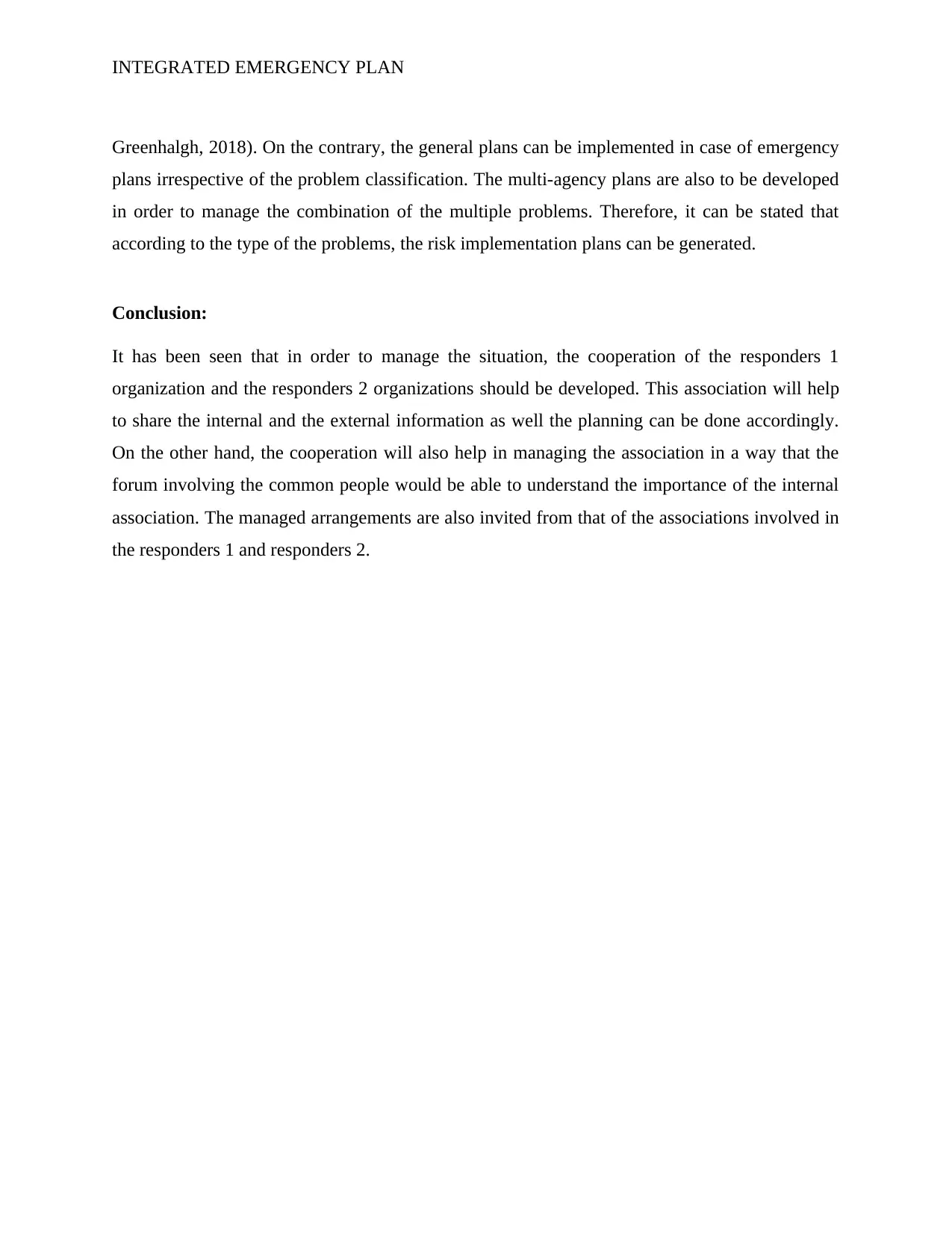
INTEGRATED EMERGENCY PLAN
Greenhalgh, 2018). On the contrary, the general plans can be implemented in case of emergency
plans irrespective of the problem classification. The multi-agency plans are also to be developed
in order to manage the combination of the multiple problems. Therefore, it can be stated that
according to the type of the problems, the risk implementation plans can be generated.
Conclusion:
It has been seen that in order to manage the situation, the cooperation of the responders 1
organization and the responders 2 organizations should be developed. This association will help
to share the internal and the external information as well the planning can be done accordingly.
On the other hand, the cooperation will also help in managing the association in a way that the
forum involving the common people would be able to understand the importance of the internal
association. The managed arrangements are also invited from that of the associations involved in
the responders 1 and responders 2.
Greenhalgh, 2018). On the contrary, the general plans can be implemented in case of emergency
plans irrespective of the problem classification. The multi-agency plans are also to be developed
in order to manage the combination of the multiple problems. Therefore, it can be stated that
according to the type of the problems, the risk implementation plans can be generated.
Conclusion:
It has been seen that in order to manage the situation, the cooperation of the responders 1
organization and the responders 2 organizations should be developed. This association will help
to share the internal and the external information as well the planning can be done accordingly.
On the other hand, the cooperation will also help in managing the association in a way that the
forum involving the common people would be able to understand the importance of the internal
association. The managed arrangements are also invited from that of the associations involved in
the responders 1 and responders 2.
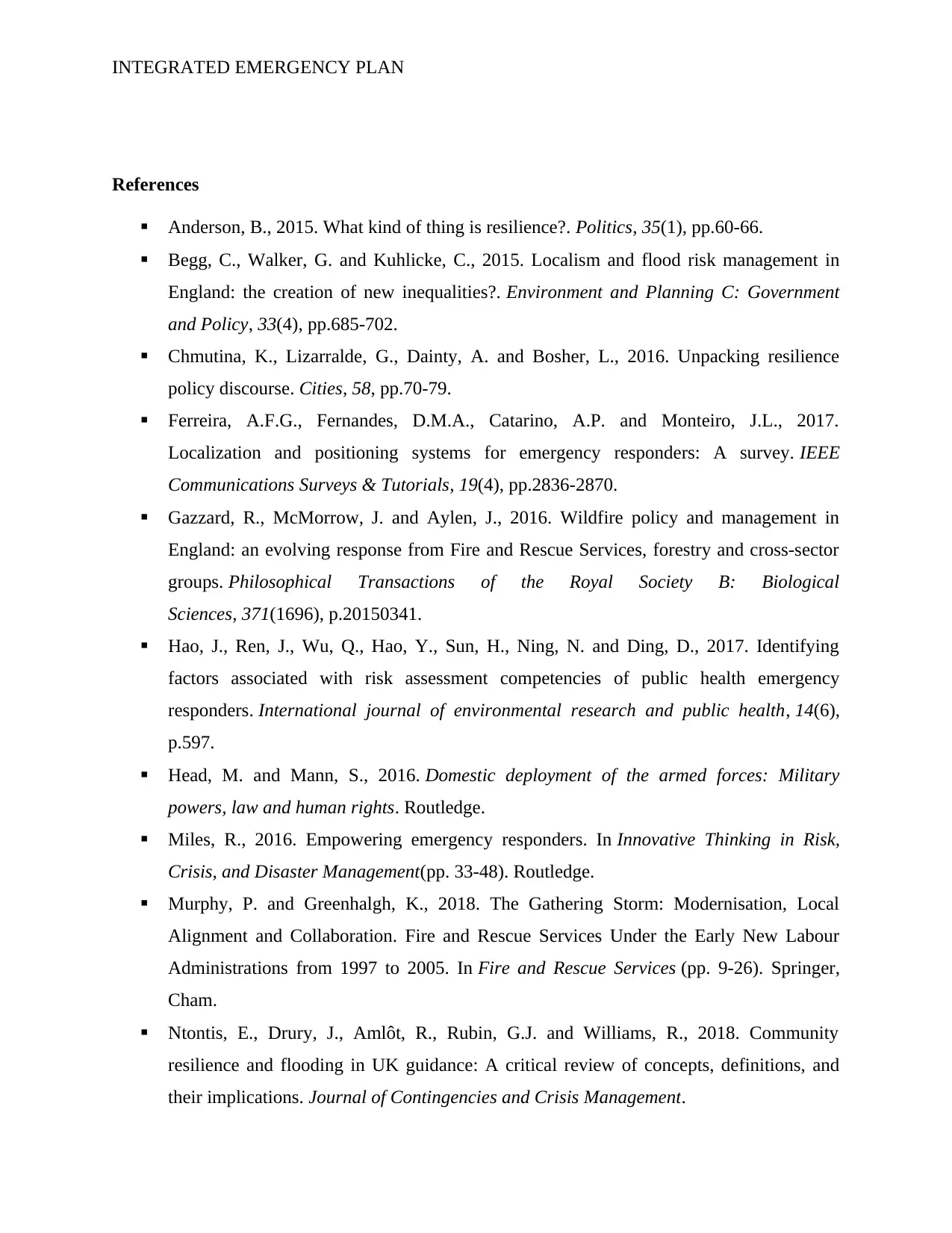
INTEGRATED EMERGENCY PLAN
References
Anderson, B., 2015. What kind of thing is resilience?. Politics, 35(1), pp.60-66.
Begg, C., Walker, G. and Kuhlicke, C., 2015. Localism and flood risk management in
England: the creation of new inequalities?. Environment and Planning C: Government
and Policy, 33(4), pp.685-702.
Chmutina, K., Lizarralde, G., Dainty, A. and Bosher, L., 2016. Unpacking resilience
policy discourse. Cities, 58, pp.70-79.
Ferreira, A.F.G., Fernandes, D.M.A., Catarino, A.P. and Monteiro, J.L., 2017.
Localization and positioning systems for emergency responders: A survey. IEEE
Communications Surveys & Tutorials, 19(4), pp.2836-2870.
Gazzard, R., McMorrow, J. and Aylen, J., 2016. Wildfire policy and management in
England: an evolving response from Fire and Rescue Services, forestry and cross-sector
groups. Philosophical Transactions of the Royal Society B: Biological
Sciences, 371(1696), p.20150341.
Hao, J., Ren, J., Wu, Q., Hao, Y., Sun, H., Ning, N. and Ding, D., 2017. Identifying
factors associated with risk assessment competencies of public health emergency
responders. International journal of environmental research and public health, 14(6),
p.597.
Head, M. and Mann, S., 2016. Domestic deployment of the armed forces: Military
powers, law and human rights. Routledge.
Miles, R., 2016. Empowering emergency responders. In Innovative Thinking in Risk,
Crisis, and Disaster Management(pp. 33-48). Routledge.
Murphy, P. and Greenhalgh, K., 2018. The Gathering Storm: Modernisation, Local
Alignment and Collaboration. Fire and Rescue Services Under the Early New Labour
Administrations from 1997 to 2005. In Fire and Rescue Services (pp. 9-26). Springer,
Cham.
Ntontis, E., Drury, J., Amlôt, R., Rubin, G.J. and Williams, R., 2018. Community
resilience and flooding in UK guidance: A critical review of concepts, definitions, and
their implications. Journal of Contingencies and Crisis Management.
References
Anderson, B., 2015. What kind of thing is resilience?. Politics, 35(1), pp.60-66.
Begg, C., Walker, G. and Kuhlicke, C., 2015. Localism and flood risk management in
England: the creation of new inequalities?. Environment and Planning C: Government
and Policy, 33(4), pp.685-702.
Chmutina, K., Lizarralde, G., Dainty, A. and Bosher, L., 2016. Unpacking resilience
policy discourse. Cities, 58, pp.70-79.
Ferreira, A.F.G., Fernandes, D.M.A., Catarino, A.P. and Monteiro, J.L., 2017.
Localization and positioning systems for emergency responders: A survey. IEEE
Communications Surveys & Tutorials, 19(4), pp.2836-2870.
Gazzard, R., McMorrow, J. and Aylen, J., 2016. Wildfire policy and management in
England: an evolving response from Fire and Rescue Services, forestry and cross-sector
groups. Philosophical Transactions of the Royal Society B: Biological
Sciences, 371(1696), p.20150341.
Hao, J., Ren, J., Wu, Q., Hao, Y., Sun, H., Ning, N. and Ding, D., 2017. Identifying
factors associated with risk assessment competencies of public health emergency
responders. International journal of environmental research and public health, 14(6),
p.597.
Head, M. and Mann, S., 2016. Domestic deployment of the armed forces: Military
powers, law and human rights. Routledge.
Miles, R., 2016. Empowering emergency responders. In Innovative Thinking in Risk,
Crisis, and Disaster Management(pp. 33-48). Routledge.
Murphy, P. and Greenhalgh, K., 2018. The Gathering Storm: Modernisation, Local
Alignment and Collaboration. Fire and Rescue Services Under the Early New Labour
Administrations from 1997 to 2005. In Fire and Rescue Services (pp. 9-26). Springer,
Cham.
Ntontis, E., Drury, J., Amlôt, R., Rubin, G.J. and Williams, R., 2018. Community
resilience and flooding in UK guidance: A critical review of concepts, definitions, and
their implications. Journal of Contingencies and Crisis Management.
Secure Best Marks with AI Grader
Need help grading? Try our AI Grader for instant feedback on your assignments.
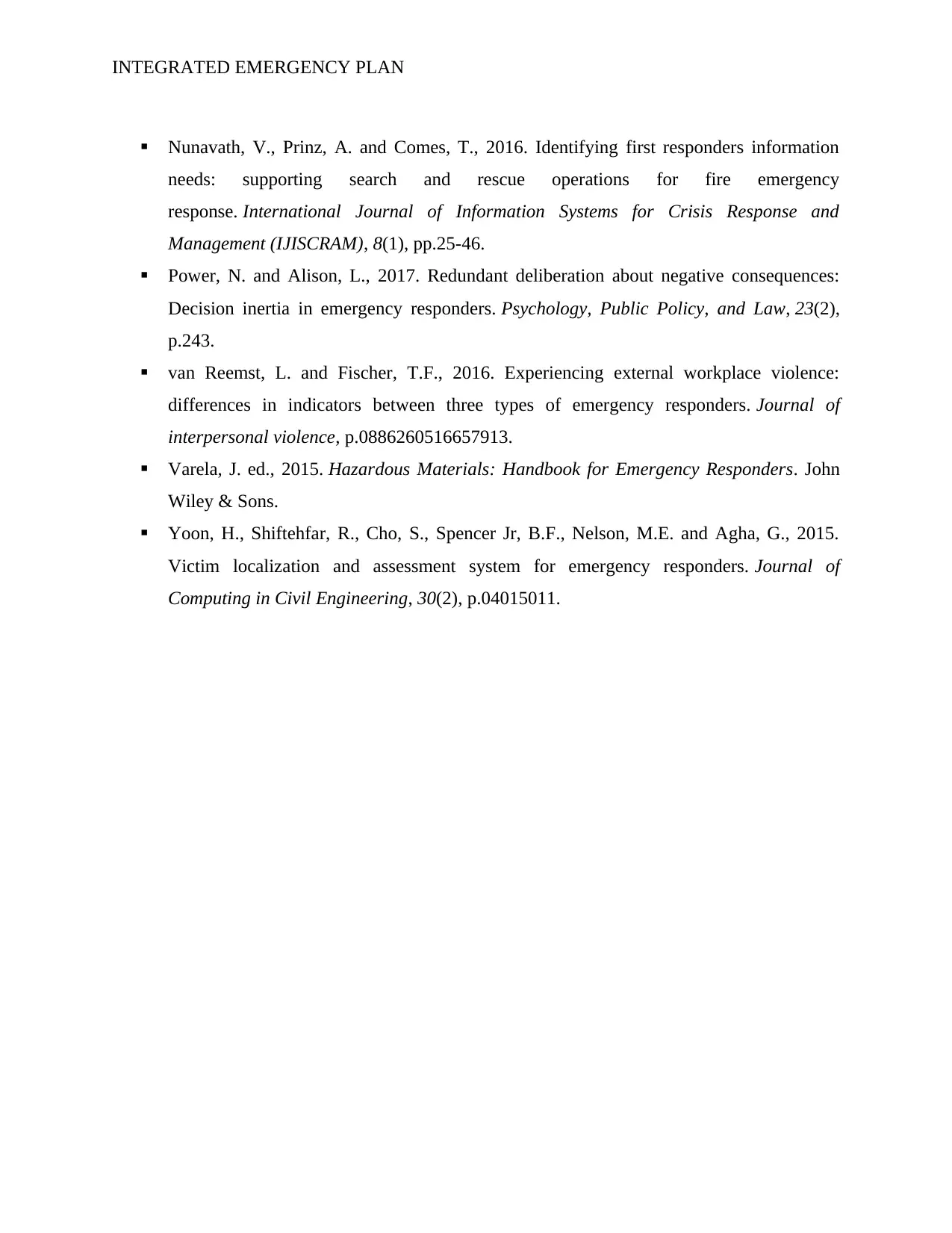
INTEGRATED EMERGENCY PLAN
Nunavath, V., Prinz, A. and Comes, T., 2016. Identifying first responders information
needs: supporting search and rescue operations for fire emergency
response. International Journal of Information Systems for Crisis Response and
Management (IJISCRAM), 8(1), pp.25-46.
Power, N. and Alison, L., 2017. Redundant deliberation about negative consequences:
Decision inertia in emergency responders. Psychology, Public Policy, and Law, 23(2),
p.243.
van Reemst, L. and Fischer, T.F., 2016. Experiencing external workplace violence:
differences in indicators between three types of emergency responders. Journal of
interpersonal violence, p.0886260516657913.
Varela, J. ed., 2015. Hazardous Materials: Handbook for Emergency Responders. John
Wiley & Sons.
Yoon, H., Shiftehfar, R., Cho, S., Spencer Jr, B.F., Nelson, M.E. and Agha, G., 2015.
Victim localization and assessment system for emergency responders. Journal of
Computing in Civil Engineering, 30(2), p.04015011.
Nunavath, V., Prinz, A. and Comes, T., 2016. Identifying first responders information
needs: supporting search and rescue operations for fire emergency
response. International Journal of Information Systems for Crisis Response and
Management (IJISCRAM), 8(1), pp.25-46.
Power, N. and Alison, L., 2017. Redundant deliberation about negative consequences:
Decision inertia in emergency responders. Psychology, Public Policy, and Law, 23(2),
p.243.
van Reemst, L. and Fischer, T.F., 2016. Experiencing external workplace violence:
differences in indicators between three types of emergency responders. Journal of
interpersonal violence, p.0886260516657913.
Varela, J. ed., 2015. Hazardous Materials: Handbook for Emergency Responders. John
Wiley & Sons.
Yoon, H., Shiftehfar, R., Cho, S., Spencer Jr, B.F., Nelson, M.E. and Agha, G., 2015.
Victim localization and assessment system for emergency responders. Journal of
Computing in Civil Engineering, 30(2), p.04015011.
1 out of 11
Related Documents
Your All-in-One AI-Powered Toolkit for Academic Success.
+13062052269
info@desklib.com
Available 24*7 on WhatsApp / Email
![[object Object]](/_next/static/media/star-bottom.7253800d.svg)
Unlock your academic potential
© 2024 | Zucol Services PVT LTD | All rights reserved.





